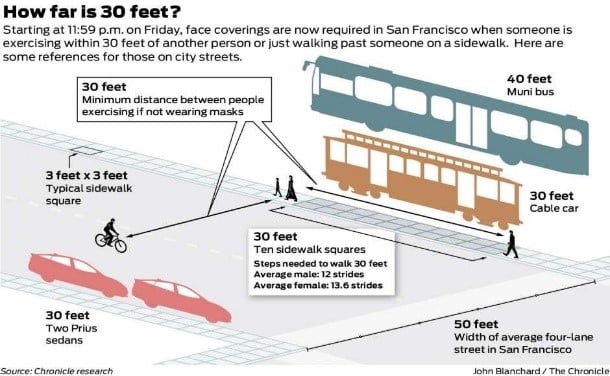Physical distancing, also commonly referred to as “social distancing,” is defined as “keeping space between yourself and other people outside of your home.” To practice physical distancing, U.S. Centers for Disease Control and Prevention (CDC) recommends staying at least six feet apart from other people. The World Health Organization recommends at least one meter (approximately three feet). But where do these numbers come from? Why six feet? Why three feet? And why the differing opinions among the public health agencies?
The primary mode of transmission for COVID-19 is through close contact from person-to-person. This occurs when an infected person coughs, sneezes, or speaks, which sprays small liquid droplets from their nose or mouth which may contain the virus. If too close, the other individual can breathe in the droplets, including the virus. But how close is too close?
WHO’s personal distancing recommendation originates from work done in the 1930s by William Wells, a Harvard researcher who studied tuberculosis. Well’s found that droplets emitted by individuals when we breathe, cough, or sneeze tend to land within three feet of where they are expelled.
CDCs recommendation of six feet is based on more recent research which was discovered during the 2003 SARS pandemic (caused by the SARS-Cov-1 virus), which found that droplets could travel farther than the three feet previously recommended and instead recommended six feet apart. Although CDC does not cite any specific study for the six-feet rule, several experts have cited this research as the most likely source for the CDC’s guideline.
However, some are now saying even six feet may not be enough distance apart. One reason being that the particle sizes may be smaller than thought and therefore can stay airborne longer. This then gives the droplets a chance to spread out even farther, and increases the likelihood that someone inhales, swallows, or touches them (and then touches their nose or mouth). One study published by MIT in March suggested “turbulent gas clouds” are released by infected individuals and can travel upwards of 23-27 feet based on various components, such as an individual patient’s physiology and environmental conditions (e.g., humidity, temperature).
Some public health agencies and organizations are using this new research to provide a more conservative approach to physical distancing guidelines. For example, on May 28, 2020, the City and County of San Francisco Department of Public Health issued an Order of the Health Officer requiring members of the public and workers to wear face coverings when outside and when anyone else other than just members of their household or living unit is within 30 feet (10 yards).

For the time being, six feet continues to be the consensus among most of the public health agencies. However, regardless of the distance provided, it is important to understand that physical distancing is only one element of infection prevention against COVID-19. It is important to stay home when you are sick, practice good hand hygiene, perform enhanced cleaning and disinfecting, and wear face masks when you are around others outside your home.
How far is 6 feet? If you don’t have a ruler, here are some creative ways to think about it:
- Average CVS receipt
- Bernie Sanders
- Typical Christmas tree
- Six bowling pins stacked on top of each other
- Standard yoga mat
- A 6-foot ladder
- A MacBook charger
- High school gym locker
- On the golf course: 43 golf balls, or two 8-irons end to end
- Two grocery carts, front to back